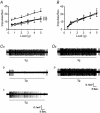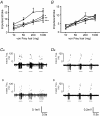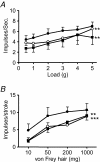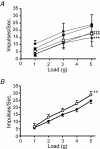Involvement of galanin receptors 1 and 2 in the modulation of mouse vagal afferent mechanosensitivity
- PMID: 17627995
- PMCID: PMC2277026
- DOI: 10.1113/jphysiol.2007.135939
Involvement of galanin receptors 1 and 2 in the modulation of mouse vagal afferent mechanosensitivity
Abstract
It is established that the gut peptide galanin reduces neuronal excitability via galanin receptor subtypes GALR1 and GALR3 and increases excitability via subtype GALR2. We have previously shown that galanin potently reduces mechanosensitivity in the majority of gastro-oesophageal vagal afferents, and potentiates sensitivity in a minority. These actions may have implications for therapeutic inhibition of gut afferent signalling. Here we investigated which galanin receptors are likely to mediate these effects. We performed quantitative RT-PCR on RNA from vagal (nodose) sensory ganglia, which indicated that all three GALR subtypes were expressed at similar levels. The responses of mouse gastro-oesophageal vagal afferents to graded mechanical stimuli were investigated before and during application of galanin receptor ligands to their peripheral endings. Two types of vagal afferents were tested: tension receptors, which respond to circumferential tension, and mucosal receptors which respond only to mucosal stroking. Galanin induced potent inhibition of mechanosensitivity in both types of afferents. This effect was totally lost in mice with targeted deletion of Galr1. The GALR1/2 agonist AR-M961 caused inhibition of mechanosensitivity in Galr1+/+ mice, but this was reversed to potentiation in Galr1-/- mice, indicating a minor role for GALR2 in potentiation of vagal afferents. We observed no functional evidence of GALR3 involvement, despite its expression in nodose ganglia. The current study highlights the complex actions of galanin at different receptor subtypes exhibiting parallels with the function of galanin in other systems.
Figures





Similar articles
-
Modulation of gastro-oesophageal vagal afferents by galanin in mouse and ferret.J Physiol. 2005 Mar 15;563(Pt 3):809-19. doi: 10.1113/jphysiol.2004.075291. Epub 2005 Jan 6. J Physiol. 2005. PMID: 15637101 Free PMC article.
-
Ghrelin selectively reduces mechanosensitivity of upper gastrointestinal vagal afferents.Am J Physiol Gastrointest Liver Physiol. 2007 May;292(5):G1376-84. doi: 10.1152/ajpgi.00536.2006. Epub 2007 Feb 8. Am J Physiol Gastrointest Liver Physiol. 2007. PMID: 17290011
-
Potentiation of mouse vagal afferent mechanosensitivity by ionotropic and metabotropic glutamate receptors.J Physiol. 2006 Nov 15;577(Pt 1):295-306. doi: 10.1113/jphysiol.2006.117762. Epub 2006 Aug 31. J Physiol. 2006. PMID: 16945965 Free PMC article.
-
Regulation of limbic status epilepticus by hippocampal galanin type 1 and type 2 receptors.Neuropeptides. 2005 Jun;39(3):277-80. doi: 10.1016/j.npep.2004.12.003. Epub 2005 Jan 28. Neuropeptides. 2005. PMID: 15944022 Review.
-
Galanin receptor subtypes 1 and 2 as therapeutic targets in head and neck squamous cell carcinoma.Expert Opin Ther Targets. 2010 Mar;14(3):289-302. doi: 10.1517/14728221003598922. Expert Opin Ther Targets. 2010. PMID: 20148716 Review.
Cited by
-
Development of Spexin-based Human Galanin Receptor Type II-Specific Agonists with Increased Stability in Serum and Anxiolytic Effect in Mice.Sci Rep. 2016 Feb 24;6:21453. doi: 10.1038/srep21453. Sci Rep. 2016. PMID: 26907960 Free PMC article.
-
Inhibition of visceral nociceptors.Front Pharmacol. 2014 Apr 14;5:72. doi: 10.3389/fphar.2014.00072. eCollection 2014. Front Pharmacol. 2014. PMID: 24782775 Free PMC article. No abstract available.
-
The Influence of Gastric Antral Ulcerations on the Expression of Galanin and GalR1, GalR2, GalR3 Receptors in the Pylorus with Regard to Gastric Intrinsic Innervation of the Pyloric Sphincter.PLoS One. 2016 May 13;11(5):e0155658. doi: 10.1371/journal.pone.0155658. eCollection 2016. PLoS One. 2016. PMID: 27175780 Free PMC article.
-
The generation of knock-in mice expressing fluorescently tagged galanin receptors 1 and 2.Mol Cell Neurosci. 2015 Sep;68:258-71. doi: 10.1016/j.mcn.2015.08.006. Epub 2015 Aug 17. Mol Cell Neurosci. 2015. PMID: 26292267 Free PMC article.
-
Galanin suppresses visceral afferent responses to noxious mechanical and inflammatory stimuli.Physiol Rep. 2020 Jan;8(2):e14326. doi: 10.14814/phy2.14326. Physiol Rep. 2020. PMID: 31960596 Free PMC article.
References
-
- Blackshaw LA. Receptors and transmission in the brain-gut axis: potential for novel therapies. IV. GABAB receptors in the brain-gastroesophageal axis. Am J Physiol Gastrointest Liver Physiol. 2001;281:G311–G315. - PubMed
-
- Blackshaw LA, Staunton E, Lehmann A, Dent J. Inhibition of transient LES relaxations and reflux in ferrets by GABA receptor agonists. Am J Physiol Gastrointest Liver Physiol. 1999;277:G867–G874. - PubMed
-
- Blakeman KH, Hao JX, Xu XJ, Jacoby AS, Shine J, Crawley JN, Iismaa T, Wiesenfeld-Hallin Z. Hyperalgesia and increased neuropathic pain-like response in mice lacking galanin receptor 1 receptors. Neuroscience. 2003;117:221–227. - PubMed
Publication types
MeSH terms
Substances
LinkOut - more resources
Full Text Sources
Molecular Biology Databases
Research Materials

